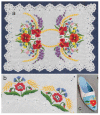Iconic Arable Weeds: The Significance of Corn Poppy (Papaver rhoeas), Cornflower (Centaurea cyanus), and Field Larkspur (Delphinium consolida) in Hungarian Ethnobotanical and Cultural Heritage
- PMID: 36616213
- PMCID: PMC9824376
- DOI: 10.3390/plants12010084
Iconic Arable Weeds: The Significance of Corn Poppy (Papaver rhoeas), Cornflower (Centaurea cyanus), and Field Larkspur (Delphinium consolida) in Hungarian Ethnobotanical and Cultural Heritage
Abstract
There are an increasing number of initiatives that recognize arable weed species as an important component of agricultural biodiversity. Such initiatives often focus on declining species that were once abundant and are still well known, but the ethnographic relevance of such species receives little recognition. We carried out an extensive literature review on the medicinal, ornamental, and cultural applications of three selected species, Papaver rhoeas, Centaurea cyanus, and Delphinium consolida, in the relevant Hungarian literature published between 1578 and 2021. We found a great diversity of medicinal usages. While P. rhoeas stands out with its sedative influence, D. consolida was mainly employed to stop bleeding, and C. cyanus was most frequently used to cure eye inflammation. The buds of P. rhoeas were sporadically eaten and its petals were used as a food dye. All species fulfilled ornamental purposes, either as garden plants or gathered in the wild for bouquets. They were essential elements of harvest festivals and religious festivities, particularly in Corpus Christi processions. P. rhoeas was also a part of several children's games. These wildflowers were regularly depicted in traditional Hungarian folk art. In poetry, P. rhoeas was used as a symbol of burning love or impermanence; C. cyanus was frequently associated with tenderness and faithfulness; while D. consolida regularly emerged as a nostalgic remembrance of the disappearing rural lifestyle. These plants were also used as patriotic symbols in illustrations for faithfulness, loyalty, or homesickness. Our results highlight the deep and prevalent embeddedness of the three iconic weed species studied in the folk culture of the Carpathian Basin. The ethnobotanical and cultural embeddedness of arable weed species should also be considered when efforts and instruments for the conservation of arable weed communities are designed.
Keywords: anthropology; arable weed conservation; charismatic species; cultural history; cultural symbols; ethnobotany; human–plants relations; medicinal plants; wild food plants.
Conflict of interest statement
The authors declare no conflict of interest.
Figures














References
-
- Naylor R.E.L., Lutman P.J. What is a weed? In: Naylor R.E.L., editor. Weed Management Handbook. Blackwell Science; Oxford, UK: 2002. pp. 1–15.
-
- Fagúndez J. The paradox of arable weeds: Diversity, conservation, and ecosystem services of the unwanted. In: Benkeblia N., editor. Agroecology, Ecosystems, and Sustainability. CRC Press; Boca Raton, FL, USA: 2014. pp. 139–149.
-
- Blaix C., Moonen A.C., Dostatny D.F., Izquierdo J., Le Corff J., Morrison J., Von Redwitz C., Schumacher M., Westerman P.R. Quantification of regulating ecosystem services provided by weeds in annual cropping systems using a systematic map approach. Weed Res. 2018;58:151–164. doi: 10.1111/wre.12303. - DOI
-
- Smith B.M., Aebischer N.J., Ewald J., Moreby S., Potter C., Holland J.M. The potential of arable weeds to reverse invertebrate declines and associated ecosystem services in cereal crops. Front. Sustain. Food Syst. 2020;3:118. doi: 10.3389/fsufs.2019.00118. - DOI
-
- Yvoz S., Cordeau S., Ploteau A., Petit S. A framework to estimate the contribution of weeds to the delivery of ecosystem (dis)services in agricultural landscapes. Ecol. Indic. 2021;132:108321. doi: 10.1016/j.ecolind.2021.108321. - DOI
Publication types
LinkOut - more resources
Full Text Sources

